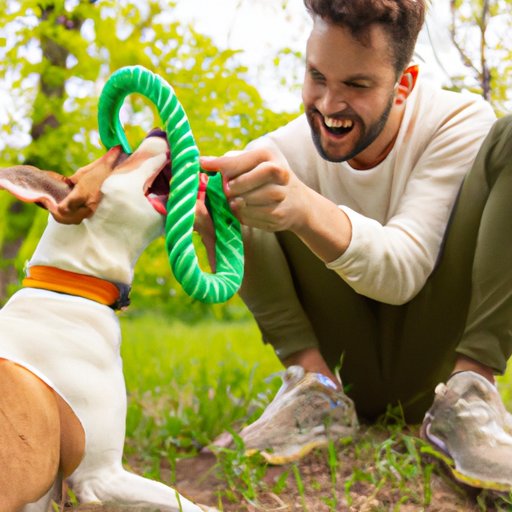
I. Introduction
Having a new puppy at home can be both exciting and challenging. As a responsible pet owner, discipline is an essential aspect of raising a well-behaved and happy pup. Puppy discipline may sound intimidating, but with the right approach and techniques, it can be an enjoyable experience for both you and your furry friend. In this article, we will explore how to discipline a puppy with care and love using positive reinforcement techniques, basic training techniques, and tips to follow for consistency in puppy discipline.
II. 5 Proven Methods to Discipline Your Puppy with Love and Care
Disciplining a puppy requires patience, consistency, and a lot of love. Punishing a puppy is never the right way to go. Instead, try redirecting the behavior, using positive reinforcement techniques, using time-outs, establishing routines, and consistently using a firm tone of voice. Redirecting your puppy’s behavior involves providing a new activity that makes your pup forget about their current behavior. Positive reinforcement techniques are ways in which you reward your dog for the desired behavior. Time-outs are an excellent way to discipline your pup, letting them cool down and think about their actions. Consistency is key to establish a routine, and a firm and consistent tone of voice is an easy method to discipline your furry friend.
III. A Beginner’s Guide to Puppy Discipline: Training Techniques You Need to Know
Discipline is an essential foundation for building a strong relationship with your pup. Building a strong foundation of discipline and training early on will help you establish healthy expectations for your pet. Basic training techniques, such as crate training, potty training, and leash training, are necessary for teaching obedience and good behavior. These training techniques are not complex but require time and patience to implement consistently.
IV. Effective Ways to Discipline Your Puppy Without Using Punishment
Punishment-based training techniques, such as physical punishment, do not work in puppy discipline. Discipline-based training is a more effective method that focuses on positive reinforcement methods that help your puppy make positive connections with good behavior. Using discipline-based training techniques, such as capturing and shaping behaviors, are much better alternatives to physical punishment. Remember, dogs learn better in a positive and safe environment.
V. Positive Reinforcement Methods in Puppy Discipline: A Step-by-Step Guide
The concept of positive reinforcement in puppy discipline involves rewarding good behavior to encourage more of it. A step-by-step guide on using positive reinforcement techniques includes identifying the behavior you want to encourage, determining the right reward, and providing feedback to your pup. Positive reinforcement techniques involve treats, toys, and praise. Providing rewards immediately is necessary when using positive reinforcement techniques, as it helps your pup make a connection between the behavior and the reward.
VI. Discipline Your Puppy with Consistency: Tips and Tricks to Follow
Consistency in puppy discipline is essential for success. Setting clear expectations and consequences, staying patient and calm, and recognizing progress are some of the specific ways to maintain consistency. Clear communication helps your pup understand what is expected of them, while recognizing progress helps build their confidence. Consistency in puppy discipline takes time and effort, but it is worth it in the long run for a happy, well-behaved pup.
VII. Building a Strong Relationship with Your Puppy through Discipline
Discipline does not mean that you can’t show your pup affection. In fact, discipline can be used as a way to build a strong bond with your fluffy friend. Combining discipline and affection through playtime and rewards, while setting boundaries, helps build mutual trust and respect. Remember, discipline and affection go hand in hand.
VIII. The Do’s and Don’ts of Puppy Discipline: Common Mistakes You Should Avoid
Mistakes are inevitable in puppy discipline, but understanding your puppy’s needs and personality can help you avoid them. Avoiding physical punishment and not expecting too much too soon are some of the common mistakes to avoid. Knowing when to end the training session and keeping things positive are equally important.
IX. Conclusion
Disciplining a puppy with care and love can be a rewarding experience. Using positive reinforcement techniques, basic training techniques, and consistently following some specific tips and tricks, such as building a strong relationship by combining discipline and affection, will help your pup become an obedient and happy member of your family. Remember, consistency is key to success in puppy discipline.
For additional resources on puppy discipline and dog training, visit your local pet store or consult an expert dog trainer.




